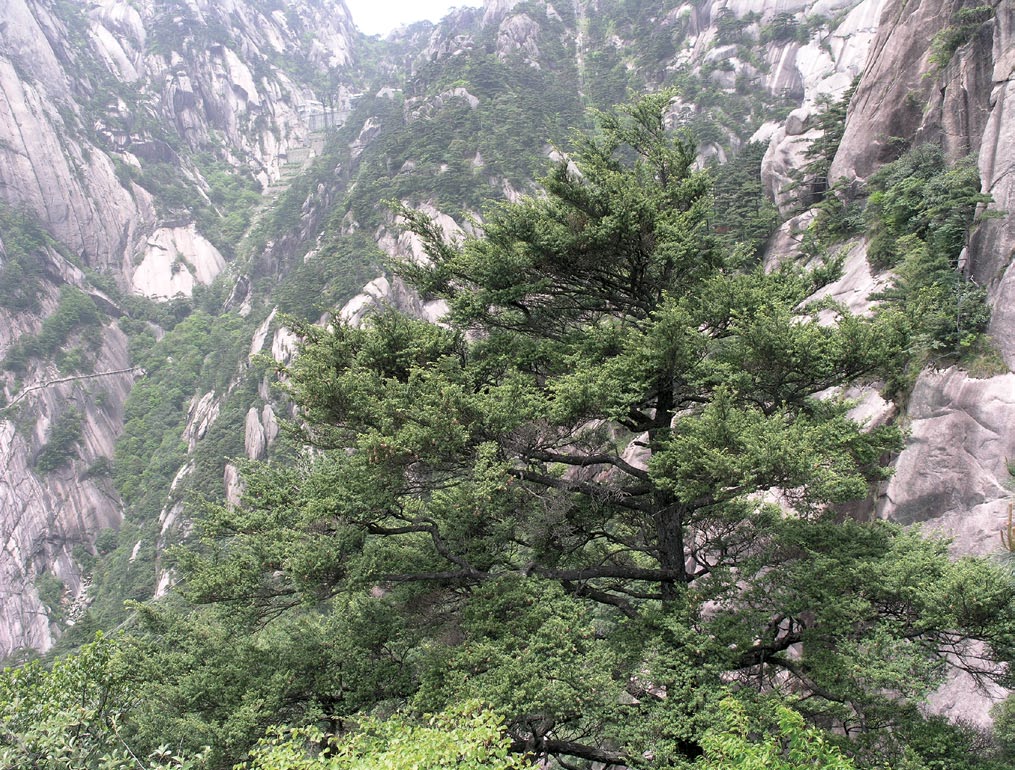One of the most important of all NACPEC collections is the Chinese hemlock (Tsuga chinensis). Prior to 1979, this species appears to have been successfully introduced into North America only once—a single seedling collected by E. H. Wilson in Hubei, China, in 1910 that is still alive today. This accession has been frequently propagated and widely distributed by the Arnold Arboretum. The lack of Chinese hemlock diversity became a significant factor when horticulturists began to notice that the species was highly resistant to the Japanese strain of hemlock woolly adelgid (HWA) that was ravaging native stands of eastern hemlock (Tsuga canadensis) throughout the central and southern portion of its range in eastern North America.
Working through its various Chinese contacts, NACPEC began a concerted effort to acquire Chinese hemlock germplasm in order to facilitate research on its growth rate, habitat tolerances, and resistance to HWA. The collections began in 1994 with seeds provided by the Xian Botanical Garden and peaked in 1996 with 6 separate collections from various habitats in the Qinling Mountains in Shaanxi Province, the northern part of its range. In all, some 33 different collections of three different varieties of the species were made. Representatives from 19 of these collections—totaling some 250 plants—are growing at various NACPEC gardens. The largest of them is at the Morris Arboretum and has reached 4.9 meters (16 feet) in height with DBH (diameter at breast height) of 9 centimeters (3.5 inches) after 10 years of growth. True to initial reports, Chinese hemlock has so far proved completely resistant to HWA in a wide variety of North American locations. It is fully cold hardy into USDA Zone 5 (average annual minimum temperature -10 to -20°F [-23.3 to -28.9°C]) and is relatively fast growing—the mean height of 38 seedlings growing under variable conditions on Hemlock Hill at the Arnold Arboretum was 169 centimeters (66.5 inches) at 10 years of age.



I observed Chinese hemlock at the Arnold Arboretum during the 2009 growing season and noted that the species both began growing and stopped growing about two weeks earlier than eastern hemlock. Interestingly, the new growth on vigorous terminal shoots was the same for both species—about 45 centimeters (17.7 inches)—which was the greatest among the seven hemlock species measured. Compared to eastern hemlock, Chinese hemlock is a bit “droopier” during the growing season, seems to be comparably shade tolerant (although this trait has not actually been quantified), is less cold hardy—Zone 5 versus Zone 3 (average annual minimum temperature -30 to -40°F [-34.4 to -40°C])—and, as mentioned, has the great advantage of adelgid resistance. It is a terrific plant for replacing adelgid-killed eastern hemlocks under cultivated conditions.
References
Del Tredici, P. and A. Kitajima. 2004. Introduction and cultivation of Chinese hemlock (Tsuga chinensis) and its resistance to hemlock woolly adelgid (Adelges tsugae). Journal of Arboriculture 30(5): 282–287.
Citation: Del Tredici, P. 2010. Chinese hemlock: Tsuga chinensis. Arnoldia, 68(2): 64–67.
Bentz, S. E., L. G. H. Riedel, M. R. Pooler, and A. M. Townsend. 2002. Hybridization and self-compatibility in controlled pollinations of eastern North American and Asian hemlock (Tsuga) species. Journal of Arboriculture 28(4): 200–205.
Hooper, B. K., R. M. Bates, J. C. Sellmer, and G. A. Hoover. 2009. Challenging Chinese hemlock (Tsuga chinensis) with hemlock woolly adelgid (Adelges tsugae) ovisacs. Arboriculture and Urban Forestry 35(1): 1–4.
Peter Del Tredici is a Senior Research Scientist at the Arnold Arboretum.
